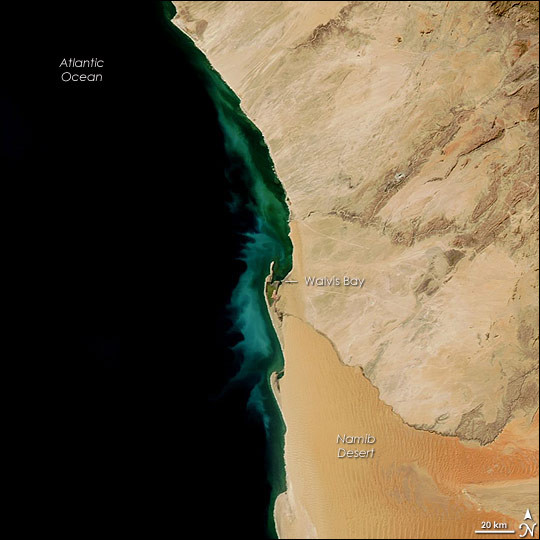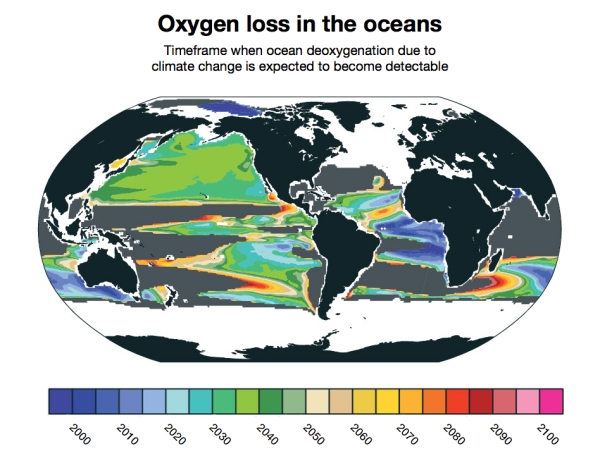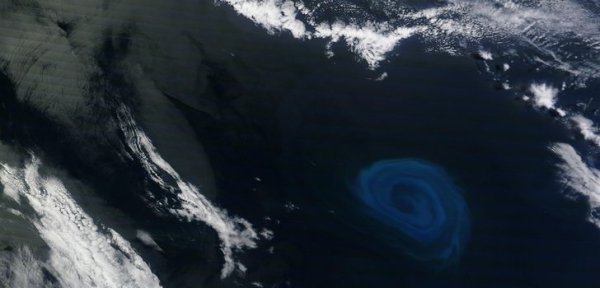NCAR: Global Temperature Increase Depletes Oxygen in Most Ocean Zones by the 2030s
A
reduction in the amount of oxygen dissolved in the oceans due to
climate change is already discernible in some parts of the world and
should be evident across large regions of the oceans between 2030 and
2040. —
The National Center for Atmospheric Research in
a press release on
April 27th.
*****
28
April, 2016
Loss
of oxygen in the world’s oceans. It’s one of those really, really
bad effects of a human-forced warming of our Earth. One of the those
climate monsters in the closet that
Steve Pacala talks about.
The kind of thing we really don’t want to set lose.
Deoxygenated
Oceans as Major Killing Mechanism During Hothouse Extinctions
The
damage caused by ocean oxygen loss is multi-variant and wide-ranging.
The most obvious harm comes in the form of generating environments in
which oxygen-dependent life in the oceans can no longer breathe. Any
living creature that filters oxygen out of the water for respiration
falls under threat due to lowered ocean oxygen levels. A group that
includes pretty much all the advanced, multi-cellular life in the
seas.
Scientists know that a warming climate can be expected to gradually sap the ocean of oxygen, leaving fish, crabs, squid, sea stars, and other marine life struggling to breathe.
(Hydrogen
sulfide producing bacteria blooms off the coast of Namibia during
2007. Hydrogen sulfide is a highly toxic gas. One that is produced by
microbes that live in waters containing little or no oxygen. Image
source: Earth
Observatory.)
But
a second, less immediately obvious hit comes in the form of
generating expanding anoxic environments that favor the proliferation
of toxin-producing microbes. Called dead zones, these oxygen-poor
regions not only provide a suffocation threat to sea life, but they
also form areas of water in which environmental toxins can build up.
The result is a long-lasting negative impact to the health of life in
the ocean and, in the most extreme cases, on land and in the airs as
well.
The
worst of these toxin-generating microbes are the hydrogen-sulfide
producing bacteria. An ancient organism that is incompatible with
oxygen-dependent life. A
horror out of deep time that
has tended to crop up again and again on the list of usual suspects
of major hothouse extinction killers. A likely perpetrator of the big
ocean and land die offs during pretty much all global warming based
extinctions. An organism that dominated the world’s seas and likely
vented its deadly gasses into the airs of the world of the Permian —
during the
worst die-off Earth has ever seen.
In
short, hydrogen sulfide is deadly to almost all forms of life that
currently dominate the world’s oceans, lands, and airs. And the
bacteria that produces hydrogen sulfide requires oxygen-poor
environments in which to grow and thrive. A world ocean high in
oxygen keeps these little killers hidden away in the deep, dark
corners of our Earth. But heat the world ocean up. Deprive it of
oxygen. And they start to come out and become a threat (see more
in Awakening
the Horrors of the Ancient Hothouse).
Oxygen
Loss to Become Widespread by the 2030s
Already
today we see regions of the world ocean that are experiencing oxygen
loss. Some of this oxygen loss is due to a process
called eutrophication.
In eutrophication, nutrients overload the ecosystems of water-based
environments. As nutrient content rises, large bacterial blooms
emerge. Eventually, these blooms overpopulate the waters and devour
all the food sources. When the microbes then die en masse, their
decay robs the surrounding waters of oxygen — generating a dead one.
Eutrophication
has been sapping the world’s oceans of oxygen over wider and wider
regions due to both agricultural run-off (fertilizers and top soils
flushed into rivers, lakes and oceans that feed large microbial
blooms and related dead zones) and due to nitrogen fall out from
fossil fuel burning. But human forced global warming also plays a key
roll in the loss of oxygen to the world ocean system.
(According
to a new study from NCAR, ocean oxygen levels are already starting to
fall in some regions due to global warming. If warming continues,
NCAR finds that most of the world’s oceans will experience some
level of oxygen loss due to this warming and due to a related
increased stratification of surface waters. Image source: NCAR.)
The
new NCAR study provides
an excellent description of how warming the world’s surface waters
can reduce ocean oxygen levels:
The entire ocean—from the depths to the shallows—gets its oxygen supply from the surface, either directly from the atmosphere or from phytoplankton, which release oxygen into the water through photosynthesis. Warming surface waters, however, absorb less oxygen. And in a double whammy, the oxygen that is absorbed has a more difficult time traveling deeper into the ocean. That’s because as water heats up, it expands, becoming lighter than the water below it and less likely to sink.
Waters
that are less likely to sink are less likely to mix. And waters that
are less likely to mix transfer less of the atmosphere’s oxygen to
the global ocean. It’s a process called ocean
stratification.
A set of circumstances triggered by warming that can sap the world’s
waters of their ability to support life even as it enhances their
ability to generate environments favorable to toxin-producing
microbes. And in the absolute worst cases, a stratified,
oxygen-deprived ocean can transition into a dead,
life-on-Earth-threatening Canfield
Ocean.
(Mobile
ocean dead zones, like this one seen off the West African Coast
during 2015, may grow more widespread as the world’s surface waters
are depleted of oxygen due to a fossil fuel emission based warming. A
new study from NCAR both explains how warming waters can hold less
oxygen and notes that loss of oxygen to ocean surface waters becomes
very widespread by the 2030s. Image source: Biogeosciences.)
In
the NCAR study, which
is well worth reading in full,
scientists used model runs to determine when and where climate change
would start to deprive the world ocean system of oxygen. The study
found that regions off the coast of West Africa, regions west of
South America, an area to the west of Australia, and a section of the
Beaufort Sea were already experiencing lower levels of ocean oxygen
due to global warming. West African seas were the first and hardest
hit by warming in the models. This is interesting due to the
fact that
Namibia on the West Coast of Africa is
one of the only regions of the world now observed to experience
blooms of hydrogen sulfide producing bacteria that extend into the
surface waters. West
African waters have also generated a number of mobile, low-oxygen
dead zones that
have spiraled on off into the North Atlantic.
The
fact that the NCAR study indicates that global warming has already
reduced ocean oxygen levels in a region that is producing both dead
zones and, in the case of Nambia, periods during which hydrogen
sulfide producing bacteria appear at the surface, is cause for some
concern. For by the 2030s, the
NCAR model study indicates
that global warming will be actively reducing ocean oxygen levels
across the vast majority of the North Pacific, a majority of the
South Pacific, most of the South Atlantic, and pretty much all of the
Indian Ocean region covered in the new research. This raises the risk
that open water dead zones like the ones seen off Africa and even
hydrogen sulfide producing hot spots like Nambia may begin to creep
into other regions of the world ocean — generating further threats
to sea life, to fishing industry, and to human beings who depend on
healthy oceans for livelihood and for life.
Links:
Hat
Tip to Colorado Bob
Hat
Tip to June






No comments:
Post a Comment
Note: only a member of this blog may post a comment.